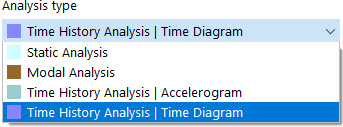In the Main tab, you can assign the analysis types and define additional parameters. To do this, select the load case in the "list" on the left.
Categories
This section covers the basic settings for a time history analysis of the load case.
Analysis Type
Once you have activated the "Time History Analysis" add-on in the model's Base Data, both analysis types Time History Analysis | Accelerogram and Time History Analysis | Time Diagram are available in the list. Assign one of these analysis types to each load case for which you want to perform the time history analysis.
Time History Analysis Settings
In the list of "Time History Analysis Settings" (THS), select the specifications used for the analysis of the load case. For example, this concerns the combination expression or damping. These parameters are described in the chapter Time History Analysis Settings.
Use the
![]() button to add new time history analysis settings and the
button to add new time history analysis settings and the
![]() button to edit the selected settings.
button to edit the selected settings.
Importing Modal Analysis from Load Case
This option is displayed if you have selected the "Linear Modal" solving method in the Time History Analysis Settings. In the list of defined modal analysis load cases, specify which eigenvalue analysis should form the basis of the time history analysis.
Import Masses Only from Load Case / Combination
This option is displayed if you have selected the "Linear implicit Newmark analysis" or "Nonlinear implicit Newmark analysis" in the Time History Analysis Settings. In the list of the defined load cases and combinations, specify which loading is to be considered as a mass in the time history analysis.
Action Category
The definition of the action category is only possible for load cases of the Time History Analysis | Time Diagram analysis type. Load cases of the "Time History Analysis | Accelerogram" type are automatically assigned to the "Seismic actions (AE)" category.
Options
You can access the "Structure modification" check box if you have selected the "Linear implicit Newmark analysis" or "Nonlinear implicit Newmark analysis" in the Time History Analysis Settings. It opens the option to consider a stiffness adjustment or a special treatment of nonlinearities in the load case (see the chapter Structure Modifications of the RFEM manual). Select the appropriate structural modification in the list, or create a new modification type using the
![]() button.
button.
If you have specified the "Linear Modal" solving method in the Time History Analysis Settings, the settings of the corresponding modal analysis load case will be used.
The “Accelerograms defined differently for supports” check box is displayed if you have selected the “Time History Analysis | Accelerogram” analysis type. The consideration of different response spectra for individual supports is still under development.
Special Options
The “Consider initial state from” check box is accessible if you have selected “Linear implicit Newmark analysis” in the Time History Analysis Settings. In the list, you can select a load case or a load combination whose stiffnesses represent the initial state for the analysis of the selected load case (see the chapter Load Cases of the RFEM manual). The
![]() button to the right of the list opens the “Initial State Settings” dialog box. Define the “Initial state type” there (currently, only the “Stiffness” type is available).
button to the right of the list opens the “Initial State Settings” dialog box. Define the “Initial state type” there (currently, only the “Stiffness” type is available).
Using this option, all conditions from the selected load case are imported for the time step t = 0 and then deleted again. In addition to the imported deformations and loads, which are used to create an equilibrium state at the beginning of the calculation, all stiffness changes made in the settings of the load cases and load combinations are taken into account. This allows you to include permanent loads without temporal changes, such as the self-weight in a time history analysis. If this initial state load case is to be permanently considered in the structural system beyond the time step t = 0, it is necessary to assign it to the time history analysis with a constant time diagram (k &equals 1).


